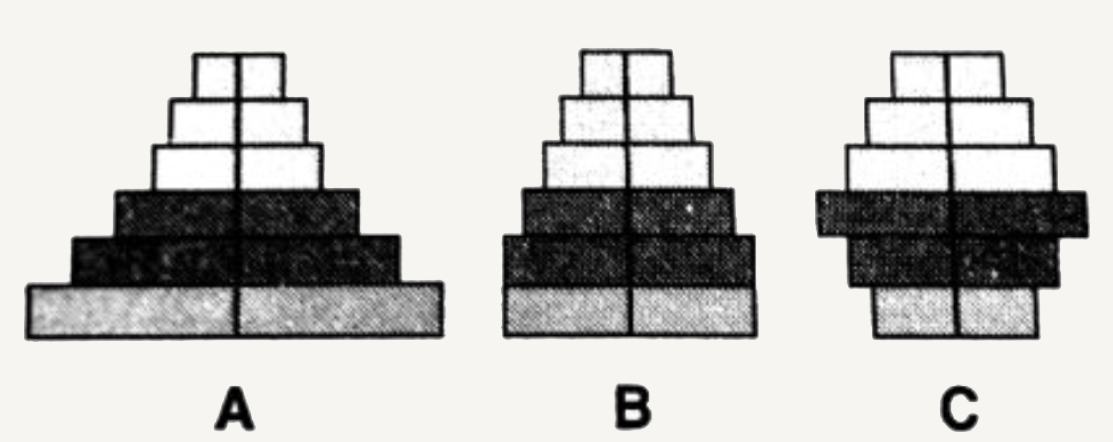A country with a high rate of population growth took measures to reduce it. The figure below shows age-sex pyramids of populations A and B twenty years apart. Select the correct interpretation about them
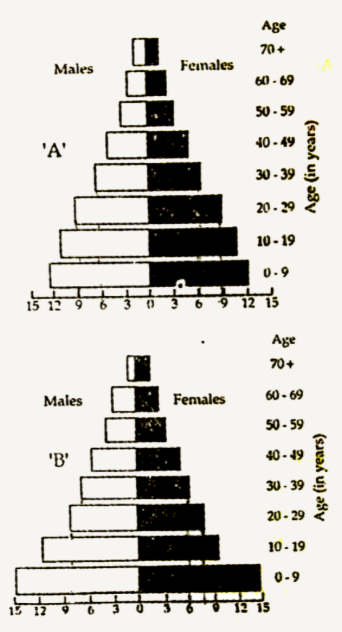
"A" is the earlier pyramid and no change has occurred in the growth rate
"A" is more recent shows slight reduction in the growth rate
"B" is earlier pyaramid and shows stabilized growth rate
"B" is more recent showing that population is very young
The correct Answer is:B
Step by step video & image solution for A country with a high rate of population growth took measures to reduce it. The figure below shows age-sex pyramids of populations A and B twenty years apart. Select the correct interpretation about them by Biology experts to help you in doubts & scoring excellent marks in Class 12 exams.
Topper's Solved these Questions
- BOOK - CENGAGE BIOLOGY ENGLISHCHAPTER - ORGANISMS AND POPULATIONSEXERCISE - ARCHIVES (Choose the correct options)29videos
ORGANISMS AND POPULATIONS
- BOOK - CENGAGE BIOLOGY ENGLISHCHAPTER - MICROBES IN HUMAN WELFAREEXERCISE - ARCHIVES26videos
MICROBES IN HUMAN WELFARE
- BOOK - CENGAGE BIOLOGY ENGLISHCHAPTER - REPRODUCTION IN ORGANISMS EXERCISE - ARCHIVES8videos
REPRODUCTION IN ORGANISMS
Similar Questions
Knowledge Check
- Question 1 - Select One
Age-sex sturcture of a population can be depicted in the form of a pyramid by plotting the percentage of population of each sex in each age class. Two age sex pyramids are given here.
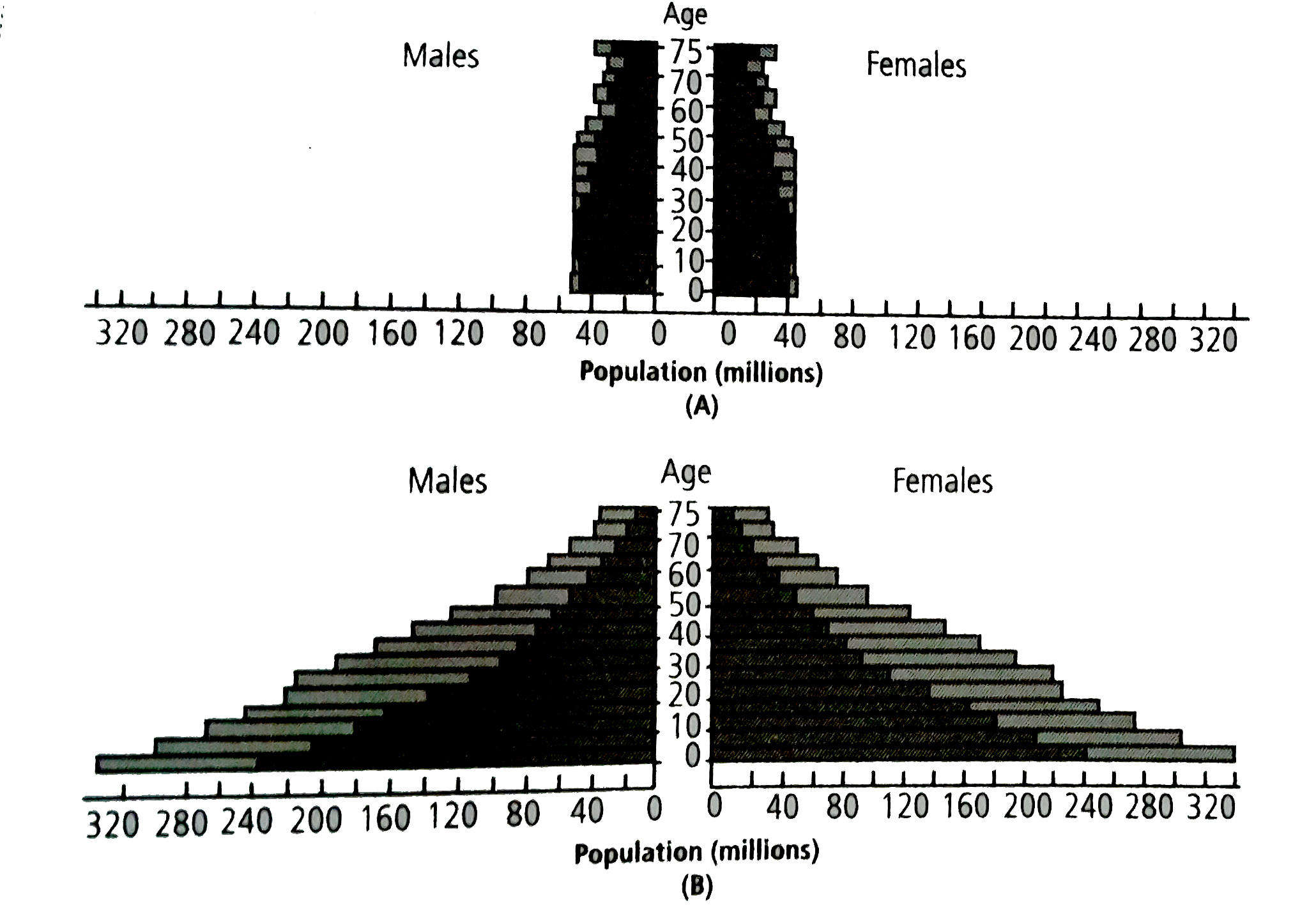
Study carefully the above age-sex pyramids and select the correct statements regarding these.AA represents the age-sex pyramid for a developed country and B represents the age-sex pyramid for a developing country.BB is a much less steep pyramid, representing a radpdly growing population, like that of india, as it has a much larger number of young people.CA is a stepper pyramid, which represents a nearly stable populationDAll of these - Question 2 - Select One
The given figure shows growth of two leaves over the period of one day. If AG= absolute growth and RGR= relative growth rate, then select the correct option.
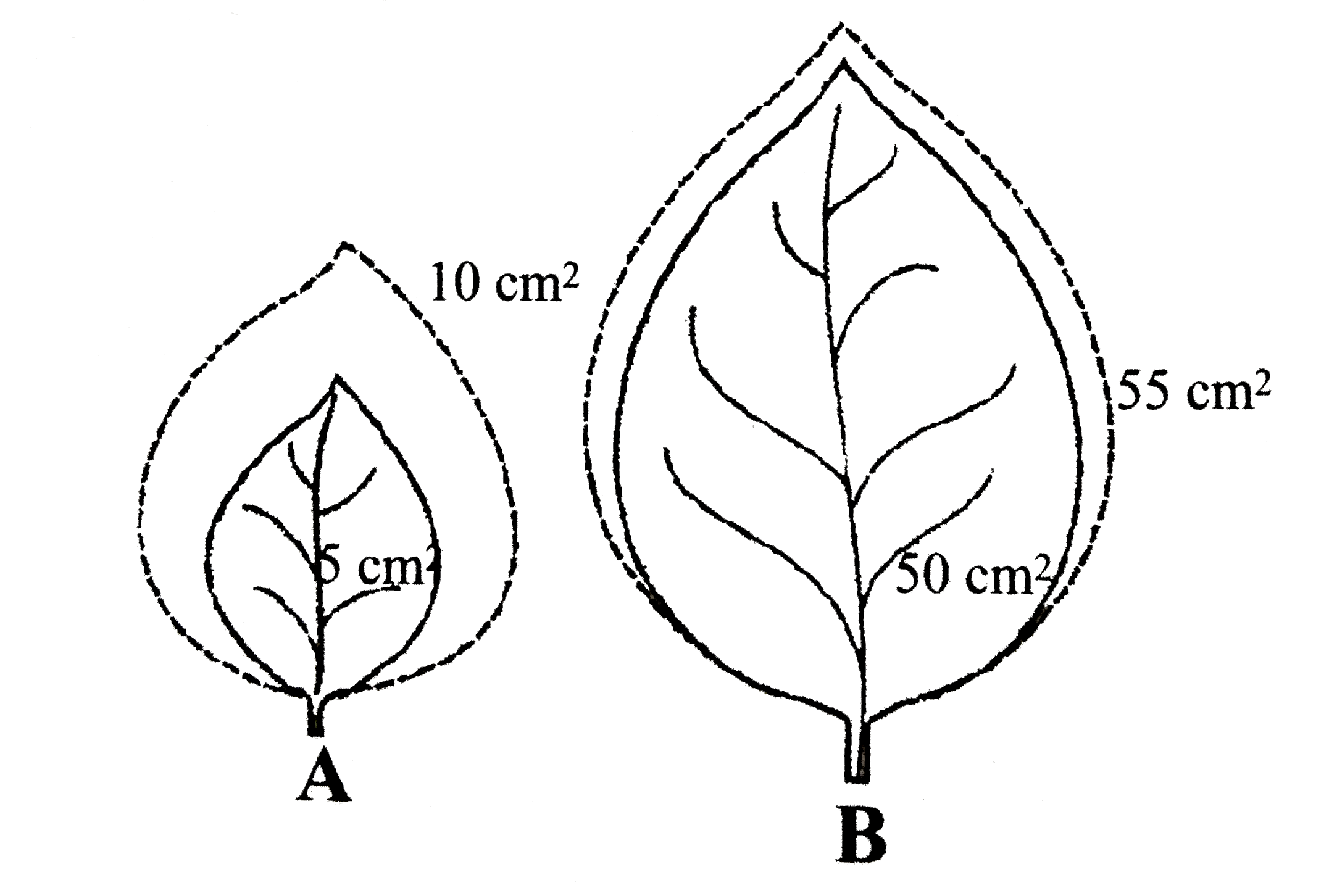 AAGfor leafARGRfor leafAAGfor leafBRGrfor leafB1%12%2BAGfor leafARGRfor leafAAGfor leafBRGrfor leafB100%510%5CAGfor leafARGRfor leafAAGfor leafBRGrfor leafB5100%510%DAGfor leafARGRfor leafAAGfor leafBRGrfor leafB5100%5100%
AAGfor leafARGRfor leafAAGfor leafBRGrfor leafB1%12%2BAGfor leafARGRfor leafAAGfor leafBRGrfor leafB100%510%5CAGfor leafARGRfor leafAAGfor leafBRGrfor leafB5100%510%DAGfor leafARGRfor leafAAGfor leafBRGrfor leafB5100%5100% - Question 3 - Select One
The most significant way in which man differs from animals is in the use of written symbols. Alphabets can, therefore, be considered the most momentous invention in the ascent of man. The use of words enables man to master time by preserving for the posterity the best that is seen, experienced or done. The birth of the civilisation was conceived in the making of the alphabet. The knowledge of the alphabet is the first step in the education of man and is central to the whole concept of elementary education. There is an inextricable link between education and progress. South Korea and Afghanistanı provide glaring instances of progressive prosperity and decline through education and lack of education respectively. Education enables people to acquire a greater control over their destiny. Farmers in India, who ushered in the Green Revolution, could do so only after they learned about the high yield of hybrid varieties of wheat and pest resistant varieties of rice. Perhaps, the greatest use of education and knowledge has been made in the field of health and nutrition. Until recently, millions of people died every year, in tropical and sub-tropical countries of the globe, of diarrhoea. However, when they were educated that the simple solution of water sugar and salt can save people from this fatal disease, mortality rate substantially declined. The use of iodized salt has arrested the incidence of goitre throughout the world. A comparative study of the progress of different States in India firmly establishes the mutual dependence of education and development. The infant mortality rate is the lowest in the highly literate state of Kerala, It is very high in low literacy state of Uttar Pradesh. Child mortality fails as mothers leam. Female literacy is, therefore, of the utmost importance in India. Basic information about health and nutrition form an essential part of elementary education. It has been observed that educated mothers are not only able to raise healthier children by following the best and latest child rearing practices, they are also more open to use of contraceptive and mare capable of limiting the number of children. The States of Uttar Pradesh and Bihar are witnessing a population explosion, as they are very slow in removing illiteracy whereas Kerala and Tamil Nadu have been successful in curbing the growth of population through the spread of literacy and creation of awareness about effective methods of contraception. A new dimension has been added to the programme of universalisation of elementary education in India by public interest litigation (PIL) filed by S.P. Anand in the Supreme Court. This PIL seeks to enforce the right to education by obtaining a commitment from all the states and union territories of India that every child will have free and compulsory education till the age of fourteen, as was promised in the Directive Principles of State Policy, as enshrined in the Indian Constitution. Expansion in Primary education and quality improvement of higher education should be adopted as twin aims of our education policy if our country has to join the select group of enlightened and advanced nations.
Hybrid:AblendBmixtureCcross-breedDall of them
The births and deaths of four populations A, B, C and D in a year are given below. Which population has the highest growth rate?
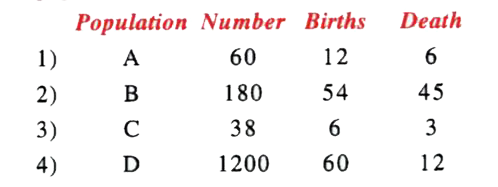 View Solution
View SolutionThe most significant way in which man differs from animals is in the use of written symbols. Alphabets can, therefore, be considered the most momentous invention in the ascent of man. The use of words enables man to master time by preserving for the posterity the best that is seen, experienced or done. The birth of the civilisation was conceived in the making of the alphabet. The knowledge of the alphabet is the first step in the education of man and is central to the whole concept of elementary education. There is an inextricable link between education and progress. South Korea and Afghanistanı provide glaring instances of progressive prosperity and decline through education and lack of education respectively. Education enables people to acquire a greater control over their destiny. Farmers in India, who ushered in the Green Revolution, could do so only after they learned about the high yield of hybrid varieties of wheat and pest resistant varieties of rice. Perhaps, the greatest use of education and knowledge has been made in the field of health and nutrition. Until recently, millions of people died every year, in tropical and sub-tropical countries of the globe, of diarrhoea. However, when they were educated that the simple solution of water sugar and salt can save people from this fatal disease, mortality rate substantially declined. The use of iodized salt has arrested the incidence of goitre throughout the world. A comparative study of the progress of different States in India firmly establishes the mutual dependence of education and development. The infant mortality rate is the lowest in the highly literate state of Kerala, It is very high in low literacy state of Uttar Pradesh. Child mortality fails as mothers leam. Female literacy is, therefore, of the utmost importance in India. Basic information about health and nutrition form an essential part of elementary education. It has been observed that educated mothers are not only able to raise healthier children by following the best and latest child rearing practices, they are also more open to use of contraceptive and mare capable of limiting the number of children. The States of Uttar Pradesh and Bihar are witnessing a population explosion, as they are very slow in removing illiteracy whereas Kerala and Tamil Nadu have been successful in curbing the growth of population through the spread of literacy and creation of awareness about effective methods of contraception. A new dimension has been added to the programme of universalisation of elementary education in India by public interest litigation (PIL) filed by S.P. Anand in the Supreme Court. This PIL seeks to enforce the right to education by obtaining a commitment from all the states and union territories of India that every child will have free and compulsory education till the age of fourteen, as was promised in the Directive Principles of State Policy, as enshrined in the Indian Constitution. Expansion in Primary education and quality improvement of higher education should be adopted as twin aims of our education policy if our country has to join the select group of enlightened and advanced nations.
Master:View SolutionThe most significant way in which man differs from animals is in the use of written symbols. Alphabets can, therefore, be considered the most momentous invention in the ascent of man. The use of words enables man to master time by preserving for the posterity the best that is seen, experienced or done. The birth of the civilisation was conceived in the making of the alphabet. The knowledge of the alphabet is the first step in the education of man and is central to the whole concept of elementary education. There is an inextricable link between education and progress. South Korea and Afghanistanı provide glaring instances of progressive prosperity and decline through education and lack of education respectively. Education enables people to acquire a greater control over their destiny. Farmers in India, who ushered in the Green Revolution, could do so only after they learned about the high yield of hybrid varieties of wheat and pest resistant varieties of rice. Perhaps, the greatest use of education and knowledge has been made in the field of health and nutrition. Until recently, millions of people died every year, in tropical and sub-tropical countries of the globe, of diarrhoea. However, when they were educated that the simple solution of water sugar and salt can save people from this fatal disease, mortality rate substantially declined. The use of iodized salt has arrested the incidence of goitre throughout the world. A comparative study of the progress of different States in India firmly establishes the mutual dependence of education and development. The infant mortality rate is the lowest in the highly literate state of Kerala, It is very high in low literacy state of Uttar Pradesh. Child mortality fails as mothers leam. Female literacy is, therefore, of the utmost importance in India. Basic information about health and nutrition form an essential part of elementary education. It has been observed that educated mothers are not only able to raise healthier children by following the best and latest child rearing practices, they are also more open to use of contraceptive and mare capable of limiting the number of children. The States of Uttar Pradesh and Bihar are witnessing a population explosion, as they are very slow in removing illiteracy whereas Kerala and Tamil Nadu have been successful in curbing the growth of population through the spread of literacy and creation of awareness about effective methods of contraception. A new dimension has been added to the programme of universalisation of elementary education in India by public interest litigation (PIL) filed by S.P. Anand in the Supreme Court. This PIL seeks to enforce the right to education by obtaining a commitment from all the states and union territories of India that every child will have free and compulsory education till the age of fourteen, as was promised in the Directive Principles of State Policy, as enshrined in the Indian Constitution. Expansion in Primary education and quality improvement of higher education should be adopted as twin aims of our education policy if our country has to join the select group of enlightened and advanced nations.
Decline:View SolutionThe most significant way in which man differs from animals is in the use of written symbols. Alphabets can, therefore, be considered the most momentous invention in the ascent of man. The use of words enables man to master time by preserving for the posterity the best that is seen, experienced or done. The birth of the civilisation was conceived in the making of the alphabet. The knowledge of the alphabet is the first step in the education of man and is central to the whole concept of elementary education. There is an inextricable link between education and progress. South Korea and Afghanistanı provide glaring instances of progressive prosperity and decline through education and lack of education respectively. Education enables people to acquire a greater control over their destiny. Farmers in India, who ushered in the Green Revolution, could do so only after they learned about the high yield of hybrid varieties of wheat and pest resistant varieties of rice. Perhaps, the greatest use of education and knowledge has been made in the field of health and nutrition. Until recently, millions of people died every year, in tropical and sub-tropical countries of the globe, of diarrhoea. However, when they were educated that the simple solution of water sugar and salt can save people from this fatal disease, mortality rate substantially declined. The use of iodized salt has arrested the incidence of goitre throughout the world. A comparative study of the progress of different States in India firmly establishes the mutual dependence of education and development. The infant mortality rate is the lowest in the highly literate state of Kerala, It is very high in low literacy state of Uttar Pradesh. Child mortality fails as mothers leam. Female literacy is, therefore, of the utmost importance in India. Basic information about health and nutrition form an essential part of elementary education. It has been observed that educated mothers are not only able to raise healthier children by following the best and latest child rearing practices, they are also more open to use of contraceptive and mare capable of limiting the number of children. The States of Uttar Pradesh and Bihar are witnessing a population explosion, as they are very slow in removing illiteracy whereas Kerala and Tamil Nadu have been successful in curbing the growth of population through the spread of literacy and creation of awareness about effective methods of contraception. A new dimension has been added to the programme of universalisation of elementary education in India by public interest litigation (PIL) filed by S.P. Anand in the Supreme Court. This PIL seeks to enforce the right to education by obtaining a commitment from all the states and union territories of India that every child will have free and compulsory education till the age of fourteen, as was promised in the Directive Principles of State Policy, as enshrined in the Indian Constitution. Expansion in Primary education and quality improvement of higher education should be adopted as twin aims of our education policy if our country has to join the select group of enlightened and advanced nations.
Posterity:View SolutionThe most significant way in which man differs from animals is in the use of written symbols. Alphabets can, therefore, be considered the most momentous invention in the ascent of man. The use of words enables man to master time by preserving for the posterity the best that is seen, experienced or done. The birth of the civilisation was conceived in the making of the alphabet. The knowledge of the alphabet is the first step in the education of man and is central to the whole concept of elementary education. There is an inextricable link between education and progress. South Korea and Afghanistanı provide glaring instances of progressive prosperity and decline through education and lack of education respectively. Education enables people to acquire a greater control over their destiny. Farmers in India, who ushered in the Green Revolution, could do so only after they learned about the high yield of hybrid varieties of wheat and pest resistant varieties of rice. Perhaps, the greatest use of education and knowledge has been made in the field of health and nutrition. Until recently, millions of people died every year, in tropical and sub-tropical countries of the globe, of diarrhoea. However, when they were educated that the simple solution of water sugar and salt can save people from this fatal disease, mortality rate substantially declined. The use of iodized salt has arrested the incidence of goitre throughout the world. A comparative study of the progress of different States in India firmly establishes the mutual dependence of education and development. The infant mortality rate is the lowest in the highly literate state of Kerala, It is very high in low literacy state of Uttar Pradesh. Child mortality fails as mothers leam. Female literacy is, therefore, of the utmost importance in India. Basic information about health and nutrition form an essential part of elementary education. It has been observed that educated mothers are not only able to raise healthier children by following the best and latest child rearing practices, they are also more open to use of contraceptive and mare capable of limiting the number of children. The States of Uttar Pradesh and Bihar are witnessing a population explosion, as they are very slow in removing illiteracy whereas Kerala and Tamil Nadu have been successful in curbing the growth of population through the spread of literacy and creation of awareness about effective methods of contraception. A new dimension has been added to the programme of universalisation of elementary education in India by public interest litigation (PIL) filed by S.P. Anand in the Supreme Court. This PIL seeks to enforce the right to education by obtaining a commitment from all the states and union territories of India that every child will have free and compulsory education till the age of fourteen, as was promised in the Directive Principles of State Policy, as enshrined in the Indian Constitution. Expansion in Primary education and quality improvement of higher education should be adopted as twin aims of our education policy if our country has to join the select group of enlightened and advanced nations.
Mutual:View Solution



